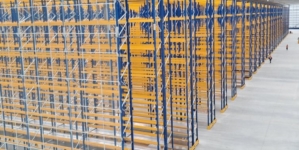-
AI startup Onton raises $7.5M to reinvent the way the world discovers and decides what to buy - November 26, 2025
-
Forklift Market Positions for Recovery as Confidence Expected to Build from 2026 - November 26, 2025
-
PROCare achieves 300% order capacity increase and 99% picking accuracy with Forterro’s ERP solution, Orderwise - November 26, 2025
-
DHL boosts operational efficiency and customer communications with HappyRobot’s AI Agents - November 25, 2025
-
STENA LINE TEAMS UP WITH CAMERA TELEMATICS TO DRIVE SAFETY IMPROVEMENTS AT IRISH SEA PORTS - November 25, 2025
-
Another design award for Toyota’s lithium-ion Traigo_i counterbalanced forklift - November 21, 2025
-
Stuut Technologies Raises $29.5 Million Series A Led by Andreessen Horowitz to Automate Accounts Receivable Work - November 20, 2025
-
INCREASED DIGITAL INVESTMENT REQUIRED TO KEEP PACE WITH 2026 CUSTOMS CHANGES - November 19, 2025
-
FULFILMENT SOLUTIONS FOR SPORTS MERCHANDISE: KEEPING OUR EYE ON THE GAME - November 19, 2025
-
COMPLEX, COSTLY & CONFUSING – THE END OF DE MINIMIS - November 19, 2025
The risk of a delivery van’s floor suffering significant and costly damage during the loading process can be eliminated
Paul Murray, JCB’s Teletruk general manager
Flooring service
According to a recent report by the Urban Transport Group, some 3.8 million vans (goods vehicles below 3.5 tonnes in weight including their cargo) are now registered in the UK.
This figure reflects an increase of 74 per cent since 1996 – with vans now representing 15 per cent of all motor vehicle traffic.
A number of factors are thought to be driving this growth, including the ever-upward spiral of the online shopping market and the resultant need to deliver internet shoppers’ orders – particularly to those consumers living in the most densely populated conurbations.
For any logistics company, running a van fleet can be a costly exercise. Tax, fuel, maintenance and insurance, all add up to significant expenditure for any company, large or small, so its important that businesses do whatever they can to minimise these costs.
Clearly the aim of any fleet manager is to ensure that vehicles are off the road for the shortest period of time possible and, to this end, ongoing maintenance regimes and driver training programmes both play a key role in cutting the amount of time that vans are out-of-action.
However, perhaps surprisingly, one of the most common causes of lost van ‘up time’ is not an engine fault deriving from poor maintenance or damage resulting from reckless driving: it is bodywork damage inflicted by poor load handling and loading techniques.
In simple terms, when it comes to van loading it is common practice for a small counterbalanced truck or pallet truck to be used to lift a palletized load into the back of a vehicle. The pallet is then often ‘slid’ into the van’s storage space either manually or using the forks of the lift truck.
But, as many fleet operators have found to their cost, there is a significant likelihood that a wooden pallet (with the inevitable protruding metal fixings) that is slid into the back of a van will often rip into the vehicle’s flooring – causing significant damage that is both costly and time consuming to repair.
But more and more logistics operators and courier firms are eliminating this problem by introducing JCB’s Teletruk technology to their operations.
Thanks to its unique telescopic mast design, which gives a forward reach of 2.4 metres, the Teletruk can deliver a pallet to the far end of a delivery vehicle without touching the floor, until the pallet is gently lowered in to position. In this way, the Teletruk greatly reduces the risk of load and vehicle damage and, of course, eliminates the risk of injury associated with manually handling loads in to vehicles.
With today’s technology-enabled consumers demanding that their online orders arrive within hours of clicking the ‘buy now’ button, there will be no let up in the rise in the number of journeys delivery vans are required to make. So fleet managers are likely to find themselves under grater pressure than ever to keep their vans on the road and eliminating unnecessary damage during the loading process should be part of their planning.

































